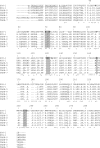SCO-1, a novel plasmid-mediated class A beta-lactamase with carbenicillinase characteristics from Escherichia coli
- PMID: 17353248
- PMCID: PMC1891400
- DOI: 10.1128/AAC.01439-06
SCO-1, a novel plasmid-mediated class A beta-lactamase with carbenicillinase characteristics from Escherichia coli
Abstract
A novel class A beta-lactamase (SCO-1) encoded by an 80-kb self-transferable plasmid from Escherichia coli is described. The interaction of SCO-1 with beta-lactams was similar to that of the CARB-type enzymes. Also, SCO-1 exhibited a 51% amino acid sequence identity with the RTG subgroup of chromosomal carbenicillinases (RTG-1, CARB-5, and CARB-8).
Figures


Comment in
-
Genetic environment of ISEcp1 and blaACC-1.Antimicrob Agents Chemother. 2007 Jul;51(7):2658-9; author reply 2659. doi: 10.1128/AAC.00364-07. Antimicrob Agents Chemother. 2007. PMID: 17684008 Free PMC article. No abstract available.
Similar articles
-
High-level cefepime resistance in Escherichia coli from Singapore producing OXA-1 beta-lactamase.Int J Antimicrob Agents. 2008 Apr;31(4):382-3. doi: 10.1016/j.ijantimicag.2007.11.004. Epub 2008 Jan 4. Int J Antimicrob Agents. 2008. PMID: 18178066 No abstract available.
-
Cloning and sequencing of the class A beta-lactamase gene (blaTEM-15) located on a chromosomal Tn801 transposon.Diagn Microbiol Infect Dis. 2007 Aug;58(4):459-63. doi: 10.1016/j.diagmicrobio.2007.02.012. Epub 2007 Apr 20. Diagn Microbiol Infect Dis. 2007. PMID: 17449209
-
[Distinction between beta-lactamases of immunotypes 1 or 2 using a new beta-lactam antbiotic (author's transl)].Ann Microbiol (Paris). 1976 May-Jun;127(4):487-91. Ann Microbiol (Paris). 1976. PMID: 788607 French.
-
Defining an extended-spectrum beta-lactamase.Clin Microbiol Infect. 2008 Jan;14 Suppl 1:3-10. doi: 10.1111/j.1469-0691.2007.01857.x. Clin Microbiol Infect. 2008. PMID: 18154524 Review.
-
Beta-lactam antibiotic resistance: a current structural perspective.Curr Opin Microbiol. 2005 Oct;8(5):525-33. doi: 10.1016/j.mib.2005.08.016. Curr Opin Microbiol. 2005. PMID: 16129657 Review.
Cited by
-
Unseen Enemy: Mechanisms of Multidrug Antimicrobial Resistance in Gram-Negative ESKAPE Pathogens.Antibiotics (Basel). 2025 Jan 9;14(1):63. doi: 10.3390/antibiotics14010063. Antibiotics (Basel). 2025. PMID: 39858349 Free PMC article. Review.
-
A Structure-Based Classification of Class A β-Lactamases, a Broadly Diverse Family of Enzymes.Clin Microbiol Rev. 2016 Jan;29(1):29-57. doi: 10.1128/CMR.00019-15. Clin Microbiol Rev. 2016. PMID: 26511485 Free PMC article. Review.
-
Sequence of pR3521, an IncB plasmid from Escherichia coli encoding ACC-4, SCO-1, and TEM-1 beta-lactamases.Antimicrob Agents Chemother. 2011 Jan;55(1):376-81. doi: 10.1128/AAC.00875-10. Epub 2010 Oct 18. Antimicrob Agents Chemother. 2011. PMID: 20956594 Free PMC article.
-
Detection of rare β-lactamase bla SCO-1 from a Klebsiella pneumoniae high-risk clone in Peru.JAC Antimicrob Resist. 2025 May 26;7(3):dlaf089. doi: 10.1093/jacamr/dlaf089. eCollection 2025 Jun. JAC Antimicrob Resist. 2025. PMID: 40421127 Free PMC article.
-
In vivo selection of a multidrug-resistant Aeromonas salmonicida during medicinal leech therapy.New Microbes New Infect. 2017 Oct 10;21:23-27. doi: 10.1016/j.nmni.2017.10.005. eCollection 2018 Jan. New Microbes New Infect. 2017. PMID: 29204282 Free PMC article.
References
MeSH terms
Substances
Associated data
- Actions
LinkOut - more resources
Full Text Sources
Chemical Information
Medical

